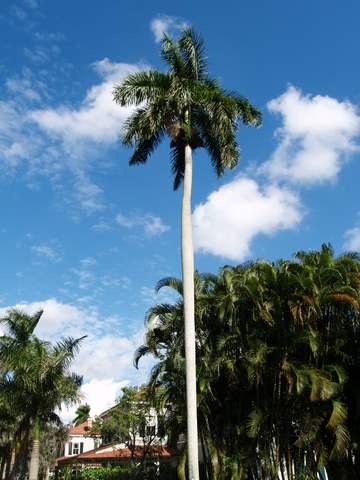

THE PALMYRA PALM.
AMONG the great family of palms none perhaps is more useful than the Palmyra palm. In the province of Tinnivelly, in South India, very little rain falls, and in consequence of the excessive drought, much of the land is uncultivated. Standing on a mountain about twenty miles from Cape Comorin, the beholder may look down upon both Tinnivelly and Travancore at once. Travancore is beautiful, with its mantle of green over hill and dale, and its bright lakes and rivers, while Tinnivelly, with its low, red sand-hills, shows few signs of cultivation. But here, in this parched and sandy district, the Palmyra palm flourishes. The cultivation of this palm involves little trouble or expense. If the nut be cast into the ground and loosely covered over with sand, it requires no more thought or care. Perhaps two or three years may pass before the young Palmyra appears above ground, but during this interval it has been busy working its way into the heart of the earth in search of water. A missionary once told us that when a well was being dug somewhere on his grounds, he found the long, stringy roots of the Palmyra forty feet beneath the surface, and still working their way downward. This furnishes a reason why the Palmyra flourishes best in a loose, sandy soil, and why in the hottest season of the year its crown yields a constant supply of cool, sweet sap.
The Hindoos say that there are eight hundred and one uses of the palm. Certain it is that every part of the tree can be made useful to man. But the most valuable product of the Palmyra palm is the sap.
The Palmyra palm grows to a height of from sixty to ninety feet, and its tall stem is usually perfectly straight, but its bark is rough from the scars of former leaves. It is destitute of branches, like other palms, but is surmounted by an erect plume of fan-shaped leaves.
The sap flows for seven or eight months of the year, and is obtained, not from the trunk, as in the maple, but from the flower-stalk or spadix at the top of the tree. A Palmyra-climber is furnished with a crutch, which, when about to climb, he rests against the stem of the tree to assist him in his ascent. He thrusts his feet through a loop of rope, to keep them close together, and clasps his arms around the trunk of the tree, and draws himself up a little way; then again extending his hands and drawing up his feet, he continues his difficult and dangerous ascent, and if accustomed to the work, soon reaches the top of the tree.
With his rude tools he cuts away the old leaves, and bruises or slices the extremities of the flowering branches, which furnish the sap, and hangs a little earthen vessel to each flower-branch to receive the sap as it flows drop by drop. It is the business of a climber to ascend the tree morning and evening to trim the spadix, and to empty into a basket made of Palmyra-leaf, which he carries with him fastened to one side of his waistcloth, all the sap that he finds collected since his last ascent.
The female members of the climber's family convert the sap into sugar by boiling. The wife gathers the firewood from the jungles and carries it home on her head. The sap is put into large earthen pots and boiled down over a slow fire. When sufficiently cooked, it is poured into molds, each formed of half a cocoanut-shell, and when cooled and hardened, is a coarse, dark sugar. If clarified and refined, it makes an excellent sugar-candy.
Palm sugar is largely used as food. The surplus sugar is sold to purchase rice or the coarse and scanty clothing usually worn by the natives.
Fifty palm trees will support a family.
Thus does God, our loving Father, supply the wants of his creatures in every part of the habitable globe.
—Helen H. Holcomb.